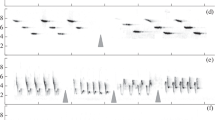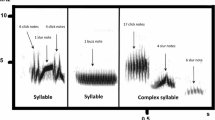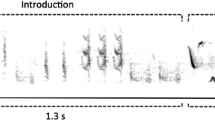Abstract
We investigated the variability of song in the Great Reed Warbler within a colour ringed population at the Müggelsee in Berlin. The repertoires of 10 individual males contained between 42 and 54 syllable types. The males showed a relatively high rate of syllable sharing in their songs (0.69 to 0.90). These similarities show a weak negative correlation with the distance of the territories involved. Quantitative and qualitative parameters in the song of individual males changed significantly within a breeding season as well as between seasons. This indicates that the birds are either able to learn new syllables during their lives or that they use different parts of a given pool of syllables. Songs recorded within a circle of about 40 km around the study site show more similarities than between songs of birds from more distant populations. Probably, this area represents the range of regular dispersal.
Zusammenfassung
Bei der Analyse der Elementrepertoires von individuell gekennzeichneten Drosselrohrsängern ergab das kumulative Auftragen neuer Elementtypen gegen die Zahl untersuchter Strophen eine deutliche Abflachung der Kurve ab der 35. Strophe. Diese Zahl muß daher als minimal notwendige Strophenzahl für die Repertoireanalyse angesehen werden. Die Repertoiregrößen von zehn Vögeln lagen zwischen 42 und 54 Elementtypen. Ein deutlicher Einfluß der Zahl der Weibchen pro Männchen auf die Repertoiregröße war nicht ersichtlich. 1993 wurden in der Teilpopulation 71 Elementtypen festgestellt, von denen 47 % so gut wie bei allen Vögeln auftraten. Die Elementsharingraten aller untersuchten Männchen-Dyaden lagen zwischen 0,69 und 0,90 und damit vergleichsweise hoch. Sie waren schwach negativ mit der Entfernung der Reviere der verglichenen Sänger korreliert. Im Laufe der Brutsaison traten bei zwei Individuen z. T. deutliche Veränderungen quantitativer Strophenparameter, des Repertoires und des Grades der Organisiertheit der Strophen auf. Ob die Vögel zu Beginn der Brutsaison eine dem Subsong ähnliche Phase durchlaufen ist unklar. Auch über zwei bzw. drei Jahre wiesen zwei Vögel z. T. erhebliche Unterschiede im dargebrachten Elementrepertoire auf. Fraglich ist, ob tatsächlich noch Änderungen des Repertoires stattfanden oder ob jeweils auf unterschiedliche Subsets des Repertoires zurückgegriffen wurde. Die Ähnlichkeit des Gesangs mit dem Müggelsee-Repertoire nahm mit dem Abstand der Herkunftsorte ab. Möglicherweise ist durch einen Umkreis von 40 km mit hoher Repertoireübereinstimmung der hauptsächliche Dismigrationsraum einer Population gekennzeichnet.
Similar content being viewed by others
Literatur
Brown, E. D., &S. M. Farabaugh (1991): Song sharing in a group living songbird, the Australian Magpie,Gymnorhina tibicen. Part III. Sex specifity and individual specifity of vocal parts in communal chorus and duet songs. Behaviour 118: 244–274.
Catchpole, C. K. (1980): Sexual Selection and the evolution of complex song among European warblers of the GenusAcrocephalus. Behaviour 74: 149–166.
Ders. (1983): Variation in the song of the Great Reed WarblerAcrocephalus arundinaceus in relation to mate attraction and territorial defence. Anim. Behav. 31: 1217–1225.
Ders. (1986): Song repertoires and reproductive success in the Great Reed WarblerAcrocephalus arundinaceus. Behav. Ecol. Sociobiol. 19: 439–445.
Ders.,B. Leisler &J. Dittami (1986): Sexual differences in the responses of captive Great Reed Warblers (Acrocephalus arundinaceus) to variation in song structure and repertoire size. Ethology 73: 69–77.
Ders.,B. Leisler &H. Winkler (1985): Polygyny in the Great Reed Warbler,Acrocephalus arundinaceus: a possible case of deception. Behav. Ecol. Sociobiol. 16: 285–291.
Ders. &A. Rowell (1993): Song sharing and local dialects in a population of the European WrenTroglodytes troglodytes. Behaviour 125: 67–78.
Conrads, K. (1976): Studien an Fremddialektsängern und Dialekt-Mischsängern des Ortolans (Emberiza hortulana). J. Orn. 117: 438–450.
Ders. &M. Kipp (1980): Ökologische und bioakustische Indizien für die Annahme einer Neuansiedlung nordskandinavischer Ortolane (Emberiza hortulana) in einem nordwestdeutschen Hochmoor. Vogelwelt 101: 41–42.
Cramp, S. &K. E. L. Simmons (1992): Handbook of the birds of Europe the Middle East and North Africa. Vol. VI. Oxford.
Dufty, A. M. (1985): Song sharing in the Brown-headed Cowbird (Molothrus ater). Z. Tierpsychol. 69: 177–190.
Eck, S. (1994): Die geographisch-morphologische Vikarianz der großen palaearktischen Rohrsänger (Aves: Passeriformes: Sylviidae:Acrocephalus [arundinaceus]). Zool. Abh. Staatl. Mus. Tierkde. Dresden 48: 161–168.
Eens, M., R. Pinxten &R. F. Verheyen (1981): Male song as a cue for mate choice in the European Starling. Behaviour 116: 210–238.
Espmark, Y. O., &H. M. Lampe (1993): Variations in the song of the Pied Flycatcher within and between breeding seasons. Bioacoustics 5: 33–65.
Fischer, St. (1993a): Brut- und Gesangsphänologie des Drosselrohrsängers (Acrocephalus arundinaceus): Hinweise zur besseren Erfassung der Art. Berl. orn. Ber. 3: 9–20.
Ders. (1993b): Zur Brutbiologie des Drosselrohrsängers (Acrocephalus arundinaceus) in Berlin. Otis 1: 29–46.
Ders. &H. Haupt (1994): Ansiedlerstreuung, Alter und Zugwege ostdeutscher Drosselrohrsänger (Acrocephalus arundinaceus) — eine Ringfundanalyse. Vogelwarte 37: 183–190.
Goodfellow, D. J., &P. J. B. Slater (1991): Can chaffinches change songs from year to year? Bioacoustics 2: 249–251.
Hamilton, W. D. (1964): The genetic theory of social behaviour. J. theor. Biol. 7: 295–311.
Hasselquist, D., &S. Bensch (1991): Trade-off between mate-guarding and mate attraction in the polygynous Great Reed Warbler. Behav. Ecol. Sociobiol. 28: 187–193.
Hedenström, A., S. Bensch, D. Hasselquist, M. Lockwood &U. Ottosson (1993): Migration, stopover and moult of the Great Reed WarblerAcrocephalus arundinaceus in Ghana, West Africa. Ibis 135: 177–180.
Hegelbach, J. (1986): Gesangsdialekt und Fortpflanzungserfolg bei Grauammer-MännchenEmberiza calandra. Orn. Beob. 83: 253–256.
Hultsch, H., &D. Todt (1981): Repertoire sharing and song-post distance in Nightingales (Luscinia megarhynchos B.). Behav. Ecol. Sociobiol. 8: 183–188.
Immelmann, K. (1983): Einführung in die Verhaltensforschung. Berlin & Hamburg.
Krebs, J. R., &N. B. Davies (1984): Einführung in die Verhaltensökologie. Stuttgart.
Marler, P. R., &S. Peters (1982): Subsong and plastic song: their role in the vocal learning process. In:Kroodsma, D. E., &E. H. Miller, Acoustic communication in birds. Vol. 2: 25–50.
Martens, J. (1980): Lautäußerungen, verwandtschaftliche Beziehungen und Verbreitungsgeschichte asiatischer Laubsänger. Fortschr. Verhaltensforsch. 22: 1–71.
Ders. &S. Eck (1991):Pnoepyga immaculata n.sp., eine neue bodenbewohnende Timalie aus dem Nepal-Himalaya. J. Orn. 132: 179–198.
Ders. &S. Hänel (1981): Gesangsformen und Verwandtschaft der asiatischen ZilpzalpePhylloscopus collybita abietinus undPh. c. sindianus. J. Orn. 123: 403–427.
Ders. &A. A. Nazarenko (1993): Microevolution of eastern palaearctic Grey Tits as indicated by their vocalizations (Parus [Poecile]: Paridae, Aves). I.Parus montanus. Z. zool. Syst. Evolut.-forsch. 31: 127–143.
Mayr, E. (1956): Gesang und Systematik. Beitr. Vogelkde. 5: 112–117.
McGregor, P. K., &J. R. Krebs (1982): Song types in a population of great tits (Parus major): their distribution, abundance and acquisition by individuals. Behaviour 79: 126–159.
Nürnberger, F., D. Siebold &H.-H. Bergmann (1989): Annual changes of learned behaviour — variation of song pattern in free-living Chaffinches,Fringilla coelebs, during the breeding season. Bioacoustics 1: 273–286.
Rich, T. (1981): Microgeographic variation in the song of the sage sparrow. Condor 83: 113–119.
Salomon, M., &Y. Hemim (1992): Song variation in the Chiffchaffs (Phylloscopus collybita) of the Western Pyrenees — the contact zone between thecollybita andbrehmii Forms. Ethology 92: 265–282.
Schottler, B. (1993): Die Lautäußerungen der Blaumeisen (Parus caeruleus) der Kanarischen Inseln — Variabilität, geographische Differenzierungen und Besiedlungsgeschichte. Diss. Univers. Mainz.
Schubert, M. (1967): Probleme der Motivwahl und der Gesangsaktivität beiPhylloscopus trochilus (L.). J. Orn. 108: 265–294.
Slater, P. J. B. (1989): Bird song learning: Causes and consequences. Ethol. Ecol. Evol. 1: 19–46.
Tembrock, G. (1977): Tierstimmenforschung. N. Brehm-Büch. 250, Wittenberg Lutherstadt.
Ders. (1992): Verhaltensbiologie. Jena.
Ders. &D. Wallschläger (1987): Bemerkungen zum Gesang des Buchfinken (Fringilla coelebs). Ann. Orn. 11: 3–12.
Whitney, C. L., &J. Miller (1987): Distribution and variability of song types in the wood thrush. Behaviour 103: 49–67.
Author information
Authors and Affiliations
Additional information
Im Gedenken an Gottfried Mauersberger
Rights and permissions
About this article
Cite this article
Fischer, S., Frommolt, KH. & Tembrock, G. Gesangsvariabilität beim DrosselrohrsängerAcrocephalus arundinaceus . J Ornithol 137, 503–513 (1996). https://doi.org/10.1007/BF01661104
Published:
Issue Date:
DOI: https://doi.org/10.1007/BF01661104




